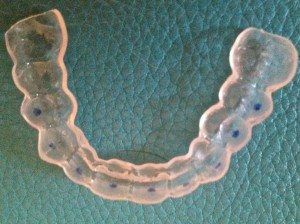Tooth Whitening FAQ

Who doesn’t want a white, bright smile? Since tooth whitening has become so popular, I wanted to share some important information on who should bleach, how and when to do it, what to expect, and different products that can be incorporated into your whitening protocol
Contraindications to Whitening
- Being too young. “Young” teeth have larger nerve canals and can become irritated from whitening. Therefore, bleaching should be avoided for those under 16 years old.
- Being pregnant or breastfeeding.
- Sensitive teeth. However, I will discuss ways to decrease sensitivity during whitening below.
- Having cavities or periodontal disease. The whitening gel will irritate diseased teeth and gums, causing pain.
- Having large dental restorations. These materials will not whiten, so they may become pronounced after bleaching.
Northstar Family Dental’s Whitening Protocol:
- Prior to treatment: Brush and floss. Make sure tray is clean and dry, as moisture will decrease the efficiency of the bleaching gel.
- Apply gel to trays. Place a SMALL drop of gel on the inner front surface of the tray. This small amount is all you need! Any more will be waste, and if it seeps out of the tray, it will cause sensitivity!
- Insert trays. Seat firmly and wipe excess gel with a q-tip or your finger.
- Wearing time. If you are bleaching for the first time, wear your tray for half the recommended time, increasing the time if little to no sensitivity is experienced.
- After whitening. Remove trays and rinse teeth. Rinse trays and remove excess bleach with a q-tip or toothbrush (not the one you brush with!)

It is very common for people to use too much bleach in their tray. I used a blue marker for effect, but those small dots are exactly where the bleach should be placed, and how small those blobs of whitening gel should be!
Should I Avoid Certain Foods and Drinks While Bleaching?It is best to avoid eating or drinking anything that can stain your teeth during bleaching, and for about 3 days after your are done. When you are actively whitening your teeth, they become dehydrated and more permeable to these staining substances. Unfortunately, this list of things you should avoid happen to be some of the things we most enjoy! But think of how white your teeth will be!!
- Dark beverages. Coffee, tea, soda, etc.
- Red wine
- Juice, smoothies, slushies, popsicles
- Sauces or marinades that contain balsamic vinegar, soy sauce, beets
- Dark chocolate
- Dark soups, stews
- Smoking, and tobacco of any kind! (Always!)
- Very hot or very cold foods and drinks. They will cause sensitivity!
If you just HAVE to have that cup of coffee, use a straw, and make sure it is not hot! Rinse your mouth out with water after drinking or eating anything that you think just might cause staining. And if you slip up, do not worry… You just may have to buy some extra bleach!
What if I Have Sensitive Teeth?


Use a sensitivity toothpaste for 2 weeks prior to bleaching (Colgate Sensitive Pro-Relief, Sensodoyne, or Prevident, which you can purchase in-office from us!) Use the toothpaste every time you brush! Purchase Topex White Care Post-Whitening Desensitizer from us, and use as directed. If you experience sensitivity when whitening, skip a day, and when you start again, leave your trays in for half the time. Ease back in to the directed time if you can… If not, you will just have more whitening sessions!
Color Stabilization and White Spots
Bleaching dehydrates your teeth. When you remove your trays, you may notice that some areas appear whiter, and some appear…well… more yellow. This color discrepancy will slowly stabilize. It may take hours to days. After your final bleaching session, your teeth will slightly rebound, then stabilize after 1-2 weeks. If you have white spots before bleaching that become more pronounced after, even, the rebound period, please let us know. There are other in-office treatments that we can use to correct this discrepancy. And always, feel free to call us or stop by if you have any questions!
